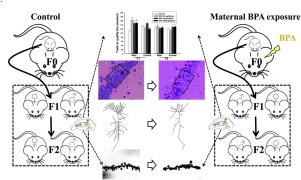当前位置:
X-MOL 学术
›
Toxicology
›
论文详情
Our official English website, www.x-mol.net, welcomes your
feedback! (Note: you will need to create a separate account there.)
Maternal exposure to environmental bisphenol A impairs the neurons in hippocampus across generations.
Toxicology ( IF 4.8 ) Pub Date : 2020-02-03 , DOI: 10.1016/j.tox.2020.152393 Haibin Zhang 1 , Zhouyu Wang 1 , Lingxue Meng 1 , Hongxuan Kuang 1 , Jian Liu 1 , Xuejing Lv 1 , Qihua Pang 1 , Ruifang Fan 2
Toxicology ( IF 4.8 ) Pub Date : 2020-02-03 , DOI: 10.1016/j.tox.2020.152393 Haibin Zhang 1 , Zhouyu Wang 1 , Lingxue Meng 1 , Hongxuan Kuang 1 , Jian Liu 1 , Xuejing Lv 1 , Qihua Pang 1 , Ruifang Fan 2
Affiliation

|
Humans from fetal to adult stages are chronically and passively exposed to bisphenol A (BPA, an endocrine disruptor) due to its ubiquitous existence in daily life. To investigate the long-term neurotoxicity of maternal exposure to BPA for offspring, mice were used as the animal model. In this study, pregnant mice (F0) were orally dosed with BPA (i.e. mice from low-, medium- and high-exposed groups were treated with 0.5, 50, 5000 μg/kg·bw of BPA per day) until weaning. Then, the first generation (F1) mice were used to generate the F2 ones. The offspring of mice not exposed to BPA served as the control groups. The Y-maze test, comet assay, hematoxylin-eosin (HE) staining method, Golgi-Cox assay and liquid chromatography-tandem mass spectrometry (LC/MS/MS) were conducted to study any alterations to learning and memory abilities, the morphological variations in hippocampal neurons and transmitter levels of F1 and F2 mice induced by BPA exposure. Results showed that even a low-dose of maternal BPA exposure could sex-dependently and significantly impair the learning and memory ability of F1 male mice, but not of generation F2. Furthermore, decreased neuron quantities and spine densities in hippocampi were observed in both F1 and F2 generations after maternal BPA exposure. However, DNA damage of brain cells were only limited to F1 offspring, in which DNA damage was only observed in the low-exposed male mice and medium-exposed female mice. Additionally, maternal BPA exposure leads to variations in hippocampal neurotransmitter levels, indicated by the decreased ratio of Glu/GABA in F1 offspring. In conclusion, maternal exposure to an environmental dose of BPA resulted in lasting adverse effects on neurological development for offspring mice.
中文翻译:

孕产妇暴露于环境双酚A会损害代代相传的海马神经元。
由于双酚A(BPA,一种内分泌干扰物)在日常生活中无处不在,因此从胎儿到成年期的人都长期和被动地暴露于双酚A。为了研究母体暴露于BPA对后代的长期神经毒性,将小鼠用作动物模型。在这项研究中,对怀孕的小鼠(F0)口服BPA(即低,中和高暴露组的小鼠每天接受0.5、50、5000μg/ kg·bw BPA处理)直至断奶。然后,使用第一代(F1)小鼠生成F2。未暴露于BPA的小鼠的后代作为对照组。进行了Y迷宫测试,彗星测定,苏木精-伊红(HE)染色方法,高尔基-柯克斯测定和液相色谱-串联质谱(LC / MS / MS),以研究学习和记忆能力的任何变化,BPA暴露诱导的F1和F2小鼠海马神经元形态变化和递质水平。结果表明,即使低剂量的母体BPA暴露也可能与性别有关,并显着损害F1雄性小鼠的学习和记忆能力,但不会损害F2代小鼠。此外,母体BPA暴露后的F1和F2代均观察到海马神经元数量和脊柱密度降低。然而,脑细胞的DNA损伤仅限于F1后代,其中仅在低暴露的雄性小鼠和中等暴露的雌性小鼠中观察到DNA损伤。此外,母体BPA暴露导致海马神经递质水平发生变化,这由F1后代中Glu / GABA的比率降低所表明。结论,
更新日期:2020-02-03
中文翻译:

孕产妇暴露于环境双酚A会损害代代相传的海马神经元。
由于双酚A(BPA,一种内分泌干扰物)在日常生活中无处不在,因此从胎儿到成年期的人都长期和被动地暴露于双酚A。为了研究母体暴露于BPA对后代的长期神经毒性,将小鼠用作动物模型。在这项研究中,对怀孕的小鼠(F0)口服BPA(即低,中和高暴露组的小鼠每天接受0.5、50、5000μg/ kg·bw BPA处理)直至断奶。然后,使用第一代(F1)小鼠生成F2。未暴露于BPA的小鼠的后代作为对照组。进行了Y迷宫测试,彗星测定,苏木精-伊红(HE)染色方法,高尔基-柯克斯测定和液相色谱-串联质谱(LC / MS / MS),以研究学习和记忆能力的任何变化,BPA暴露诱导的F1和F2小鼠海马神经元形态变化和递质水平。结果表明,即使低剂量的母体BPA暴露也可能与性别有关,并显着损害F1雄性小鼠的学习和记忆能力,但不会损害F2代小鼠。此外,母体BPA暴露后的F1和F2代均观察到海马神经元数量和脊柱密度降低。然而,脑细胞的DNA损伤仅限于F1后代,其中仅在低暴露的雄性小鼠和中等暴露的雌性小鼠中观察到DNA损伤。此外,母体BPA暴露导致海马神经递质水平发生变化,这由F1后代中Glu / GABA的比率降低所表明。结论,









































 京公网安备 11010802027423号
京公网安备 11010802027423号